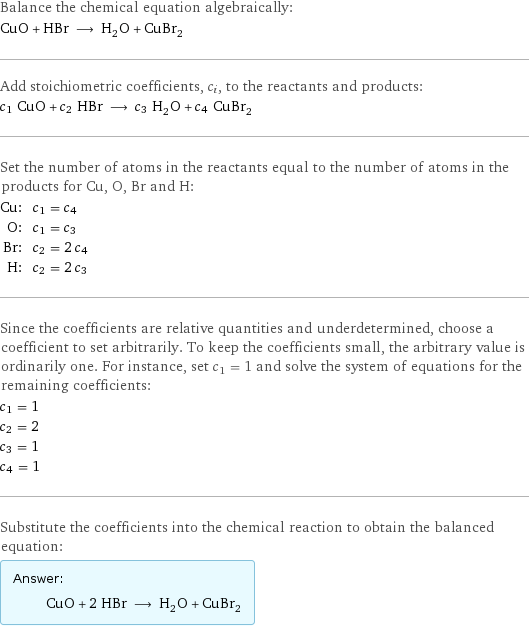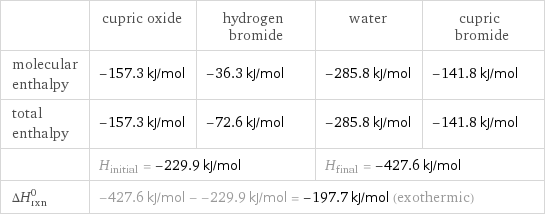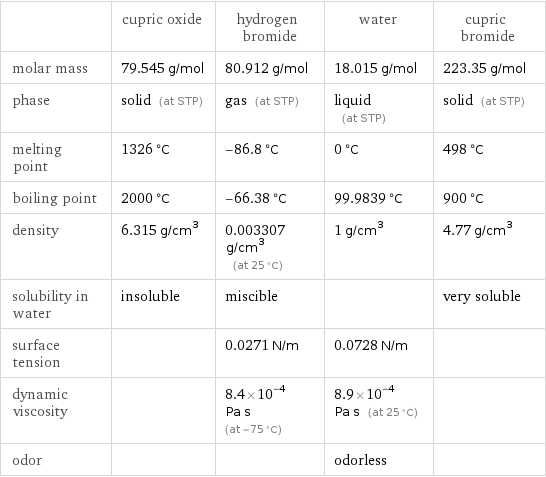Input interpretation

CuO cupric oxide + HBr hydrogen bromide ⟶ H_2O water + CuBr_2 cupric bromide
Balanced equation

Balance the chemical equation algebraically: CuO + HBr ⟶ H_2O + CuBr_2 Add stoichiometric coefficients, c_i, to the reactants and products: c_1 CuO + c_2 HBr ⟶ c_3 H_2O + c_4 CuBr_2 Set the number of atoms in the reactants equal to the number of atoms in the products for Cu, O, Br and H: Cu: | c_1 = c_4 O: | c_1 = c_3 Br: | c_2 = 2 c_4 H: | c_2 = 2 c_3 Since the coefficients are relative quantities and underdetermined, choose a coefficient to set arbitrarily. To keep the coefficients small, the arbitrary value is ordinarily one. For instance, set c_1 = 1 and solve the system of equations for the remaining coefficients: c_1 = 1 c_2 = 2 c_3 = 1 c_4 = 1 Substitute the coefficients into the chemical reaction to obtain the balanced equation: Answer: | | CuO + 2 HBr ⟶ H_2O + CuBr_2
Structures

+ ⟶ +
Names

cupric oxide + hydrogen bromide ⟶ water + cupric bromide
Reaction thermodynamics
Enthalpy

| cupric oxide | hydrogen bromide | water | cupric bromide molecular enthalpy | -157.3 kJ/mol | -36.3 kJ/mol | -285.8 kJ/mol | -141.8 kJ/mol total enthalpy | -157.3 kJ/mol | -72.6 kJ/mol | -285.8 kJ/mol | -141.8 kJ/mol | H_initial = -229.9 kJ/mol | | H_final = -427.6 kJ/mol | ΔH_rxn^0 | -427.6 kJ/mol - -229.9 kJ/mol = -197.7 kJ/mol (exothermic) | | |
Equilibrium constant
![Construct the equilibrium constant, K, expression for: CuO + HBr ⟶ H_2O + CuBr_2 Plan: • Balance the chemical equation. • Determine the stoichiometric numbers. • Assemble the activity expression for each chemical species. • Use the activity expressions to build the equilibrium constant expression. Write the balanced chemical equation: CuO + 2 HBr ⟶ H_2O + CuBr_2 Assign stoichiometric numbers, ν_i, using the stoichiometric coefficients, c_i, from the balanced chemical equation in the following manner: ν_i = -c_i for reactants and ν_i = c_i for products: chemical species | c_i | ν_i CuO | 1 | -1 HBr | 2 | -2 H_2O | 1 | 1 CuBr_2 | 1 | 1 Assemble the activity expressions accounting for the state of matter and ν_i: chemical species | c_i | ν_i | activity expression CuO | 1 | -1 | ([CuO])^(-1) HBr | 2 | -2 | ([HBr])^(-2) H_2O | 1 | 1 | [H2O] CuBr_2 | 1 | 1 | [CuBr2] The equilibrium constant symbol in the concentration basis is: K_c Mulitply the activity expressions to arrive at the K_c expression: Answer: | | K_c = ([CuO])^(-1) ([HBr])^(-2) [H2O] [CuBr2] = ([H2O] [CuBr2])/([CuO] ([HBr])^2)](../image_source/6c87f7d31ffe730442394389695d37dc.png)
Construct the equilibrium constant, K, expression for: CuO + HBr ⟶ H_2O + CuBr_2 Plan: • Balance the chemical equation. • Determine the stoichiometric numbers. • Assemble the activity expression for each chemical species. • Use the activity expressions to build the equilibrium constant expression. Write the balanced chemical equation: CuO + 2 HBr ⟶ H_2O + CuBr_2 Assign stoichiometric numbers, ν_i, using the stoichiometric coefficients, c_i, from the balanced chemical equation in the following manner: ν_i = -c_i for reactants and ν_i = c_i for products: chemical species | c_i | ν_i CuO | 1 | -1 HBr | 2 | -2 H_2O | 1 | 1 CuBr_2 | 1 | 1 Assemble the activity expressions accounting for the state of matter and ν_i: chemical species | c_i | ν_i | activity expression CuO | 1 | -1 | ([CuO])^(-1) HBr | 2 | -2 | ([HBr])^(-2) H_2O | 1 | 1 | [H2O] CuBr_2 | 1 | 1 | [CuBr2] The equilibrium constant symbol in the concentration basis is: K_c Mulitply the activity expressions to arrive at the K_c expression: Answer: | | K_c = ([CuO])^(-1) ([HBr])^(-2) [H2O] [CuBr2] = ([H2O] [CuBr2])/([CuO] ([HBr])^2)
Rate of reaction
![Construct the rate of reaction expression for: CuO + HBr ⟶ H_2O + CuBr_2 Plan: • Balance the chemical equation. • Determine the stoichiometric numbers. • Assemble the rate term for each chemical species. • Write the rate of reaction expression. Write the balanced chemical equation: CuO + 2 HBr ⟶ H_2O + CuBr_2 Assign stoichiometric numbers, ν_i, using the stoichiometric coefficients, c_i, from the balanced chemical equation in the following manner: ν_i = -c_i for reactants and ν_i = c_i for products: chemical species | c_i | ν_i CuO | 1 | -1 HBr | 2 | -2 H_2O | 1 | 1 CuBr_2 | 1 | 1 The rate term for each chemical species, B_i, is 1/ν_i(Δ[B_i])/(Δt) where [B_i] is the amount concentration and t is time: chemical species | c_i | ν_i | rate term CuO | 1 | -1 | -(Δ[CuO])/(Δt) HBr | 2 | -2 | -1/2 (Δ[HBr])/(Δt) H_2O | 1 | 1 | (Δ[H2O])/(Δt) CuBr_2 | 1 | 1 | (Δ[CuBr2])/(Δt) (for infinitesimal rate of change, replace Δ with d) Set the rate terms equal to each other to arrive at the rate expression: Answer: | | rate = -(Δ[CuO])/(Δt) = -1/2 (Δ[HBr])/(Δt) = (Δ[H2O])/(Δt) = (Δ[CuBr2])/(Δt) (assuming constant volume and no accumulation of intermediates or side products)](../image_source/79faef628845bbb25bf6083a98402b18.png)
Construct the rate of reaction expression for: CuO + HBr ⟶ H_2O + CuBr_2 Plan: • Balance the chemical equation. • Determine the stoichiometric numbers. • Assemble the rate term for each chemical species. • Write the rate of reaction expression. Write the balanced chemical equation: CuO + 2 HBr ⟶ H_2O + CuBr_2 Assign stoichiometric numbers, ν_i, using the stoichiometric coefficients, c_i, from the balanced chemical equation in the following manner: ν_i = -c_i for reactants and ν_i = c_i for products: chemical species | c_i | ν_i CuO | 1 | -1 HBr | 2 | -2 H_2O | 1 | 1 CuBr_2 | 1 | 1 The rate term for each chemical species, B_i, is 1/ν_i(Δ[B_i])/(Δt) where [B_i] is the amount concentration and t is time: chemical species | c_i | ν_i | rate term CuO | 1 | -1 | -(Δ[CuO])/(Δt) HBr | 2 | -2 | -1/2 (Δ[HBr])/(Δt) H_2O | 1 | 1 | (Δ[H2O])/(Δt) CuBr_2 | 1 | 1 | (Δ[CuBr2])/(Δt) (for infinitesimal rate of change, replace Δ with d) Set the rate terms equal to each other to arrive at the rate expression: Answer: | | rate = -(Δ[CuO])/(Δt) = -1/2 (Δ[HBr])/(Δt) = (Δ[H2O])/(Δt) = (Δ[CuBr2])/(Δt) (assuming constant volume and no accumulation of intermediates or side products)
Chemical names and formulas

| cupric oxide | hydrogen bromide | water | cupric bromide formula | CuO | HBr | H_2O | CuBr_2 Hill formula | CuO | BrH | H_2O | Br_2Cu name | cupric oxide | hydrogen bromide | water | cupric bromide IUPAC name | | hydrogen bromide | water | dibromocopper
Substance properties

| cupric oxide | hydrogen bromide | water | cupric bromide molar mass | 79.545 g/mol | 80.912 g/mol | 18.015 g/mol | 223.35 g/mol phase | solid (at STP) | gas (at STP) | liquid (at STP) | solid (at STP) melting point | 1326 °C | -86.8 °C | 0 °C | 498 °C boiling point | 2000 °C | -66.38 °C | 99.9839 °C | 900 °C density | 6.315 g/cm^3 | 0.003307 g/cm^3 (at 25 °C) | 1 g/cm^3 | 4.77 g/cm^3 solubility in water | insoluble | miscible | | very soluble surface tension | | 0.0271 N/m | 0.0728 N/m | dynamic viscosity | | 8.4×10^-4 Pa s (at -75 °C) | 8.9×10^-4 Pa s (at 25 °C) | odor | | | odorless |
Units
